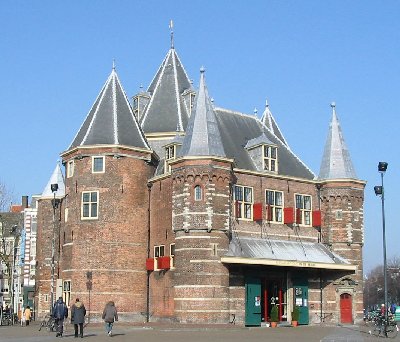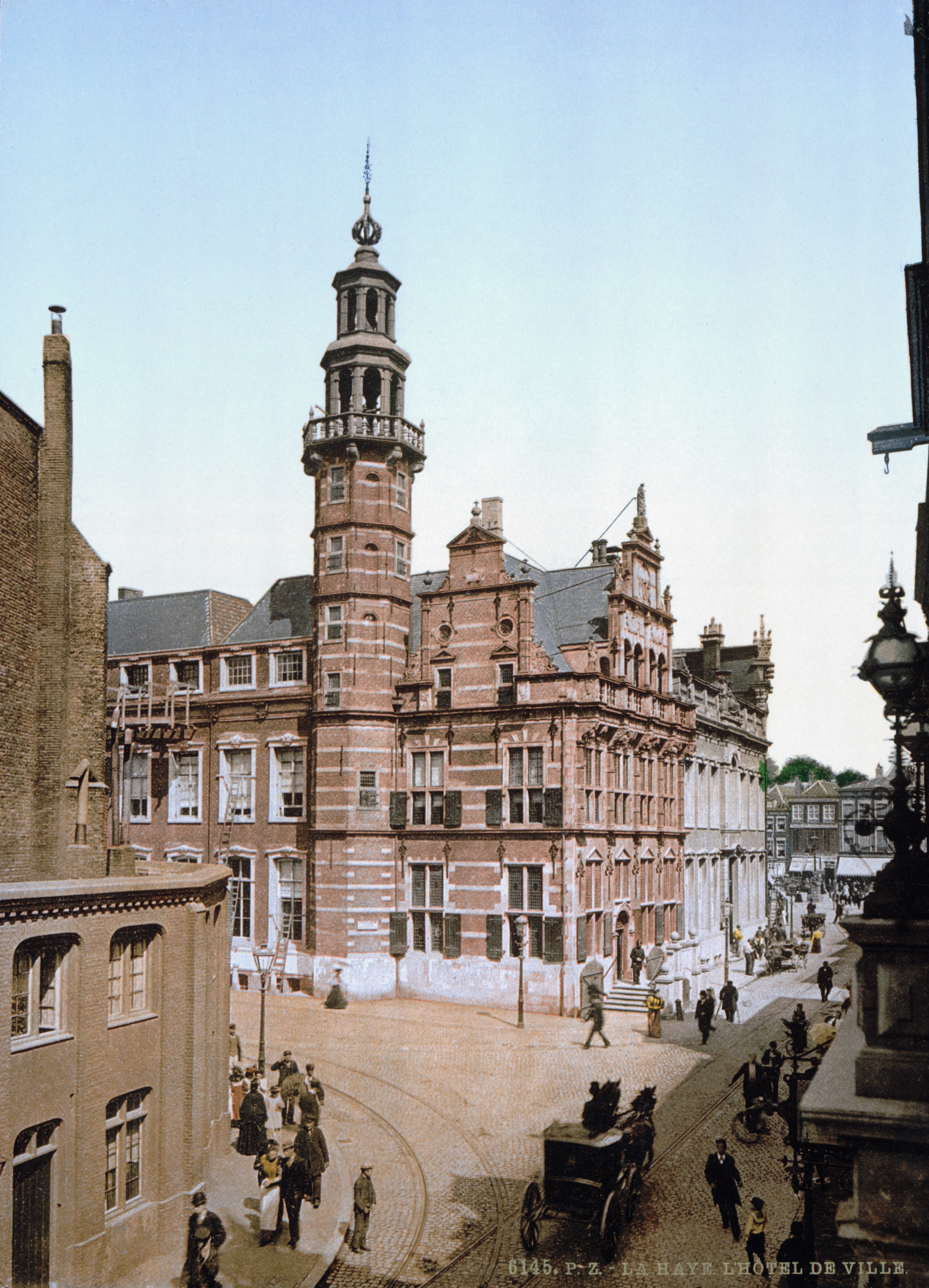|
Munttoren
The Munttoren (; "Mint Tower") or Munt () is a tower in Amsterdam, Netherlands. It stands on the busy Muntplein (Amsterdam), Muntplein square, where the Amstel river and the Singel (Amsterdam), Singel canal meet, near the flower market and the eastern end of the Kalverstraat shopping street. History The tower was originally part of the Regulierspoort, one of the main gates in Walls of Amsterdam, Amsterdam's medieval city wall. The gate, built in the years 1480, consisted of two towers and a guard house. After the gate went up in flames in a 1618 fire, only the Guardhouse, guard house and part of the western tower remained standing. The tower was then rebuilt in Amsterdam Renaissance style in 1620, with an eight-sided top half and elegant open spire designed by Hendrick de Keyser, featuring a clockwork with four clockfaces and a carillon of bells. The name of the tower refers to the fact that the guard house on the side of it was used to mint coins in the 17th century. In the ''Ra ... [...More Info...] [...Related Items...] OR: [Wikipedia] [Google] [Baidu] |
Muntplein (Amsterdam)
The Muntplein (Mint Square) is a square in the centre of Amsterdam. The square is in fact a bridge — the widest bridge in Amsterdam — that crosses the Singel canal at the point where it flows into the Amstel river. All bridges in Amsterdam are numbered, and the Muntplein carries the number 1. Muntplein is named after the Munttoren (or simply Munt) tower that stands on this square. This tower was once part of one of the three main medieval city gates. In the 17th century, it temporarily served as a mint, hence the name. The guard house building attached to the tower is not the original medieval structure but a late 19th-century fantasy. An underpass was added to the building during a 1938–1939 renovation. The name "Muntplein" dates from 1917. The square was originally known as Schapenplein ("sheep square") and, from 1877 to 1917, as Sophiaplein (after Queen Sophia, first wife of William III). The square is a bustling intersection of six streets. It forms the southern en ... [...More Info...] [...Related Items...] OR: [Wikipedia] [Google] [Baidu] |
Walls Of Amsterdam
The walls of Amsterdam () were built in the Middle Ages to protect the city against attack. The Medieval walls were replaced with a series of bastions in the 17th century. In the 19th century, the Defensive wall, walls were torn down and replaced with the Stelling van Amsterdam, Defence Line of Amsterdam (), a fortification line which encircled Amsterdam at a distance from the city. Remains of the medieval and 17th-century defenses include the former city gates Waag (Amsterdam), Waag and Munttoren, as well as the defensive tower Schreierstoren and the watchtower Montelbaanstoren. History Earthen walls Around the year 1300, an earthen wall had been erected behind the Nieuwendijk, Amsterdam, Nieuwendijk dike. Traces of this wall were discovered during archeological excavations around Nieuwezijds Kolk in 1994. Following the in 1303, Count William III of Holland withdrew the privilege of Amsterdam to have defenses, forcing the town to remove the wall. [...More Info...] [...Related Items...] OR: [Wikipedia] [Google] [Baidu] |
Hendrick De Keyser
Hendrick de Keyser (15 May 1565 – 15 May 1621) was a Dutch sculptor, merchant in Belgium bluestone, and architect who was instrumental in establishing a late Renaissance form of Mannerism changing into Baroque. Most of his works appeared in Amsterdam, some elsewhere in the Dutch Republic. He was the father of Pieter and Thomas de Keyser and Willem, and the uncle of Huybert de Keyser, who became his apprentices and all involved in building, decoration and architecture. Biography and works Hendrick de Keyser was born in Utrecht, and the son of a cabinetmaker. He grew up in an expropriated monastery, the Catalijne Convent. As a young man he was apprenticed to the engineer Cornelis Bloemaert (the elder). In 1591 he followed Bloemaert to Amsterdam and married Beyken van Wildre from Antwerp. Soon he set to work as an independent artist. In 1595 he was appointed city stonemason and sculptor. In 1603 the working on the Zuiderkerk stopped but they resumed construction in 1606, wh ... [...More Info...] [...Related Items...] OR: [Wikipedia] [Google] [Baidu] |
Pieter And François Hemony
Pieter Hemony (born Pierre Hemony; 161920 February 1680) and his brother François Hemony (24 May 1667) were the greatest bellfounders in the history of the Low Countries. They developed the carillon, in collaboration with Jacob van Eyck, into a full-fledged musical instrument by casting the first tuned carillon in 1644. The brothers' skill was unequaled in their time; after their death, their guarded trade secrets were lost, and not until the 19th century were bells of comparable tuning quality cast. Even today, most Hemony bells sound pure and clear. Life The brothers Hemony were born in Levécourt (in present-day Champagne-Ardenne, France) into a family of bell founders who travelled throughout Europe to cast bells. It is likely that they relocated their business to Germany during the Thirty Years' War, where François cast his first swinging bell. In 1641, they first cast swinging bells in the Netherlands for the Reformed Church in Goor, but their career reached ... [...More Info...] [...Related Items...] OR: [Wikipedia] [Google] [Baidu] |
Singel (Amsterdam)
The Singel () is one of the canals of Amsterdam. The Singel encircled Amsterdam in the Middle Ages, serving as a moat around the city until 1585, when Amsterdam expanded beyond the Singel. The canal runs from the IJ (Amsterdam), IJ bay, near the Amsterdam Centraal, Central Station, to the Muntplein (Amsterdam), Muntplein square, where it meets the Amstel river. It is now the inner-most canal in Amsterdam's semicircular ring of canals. The canal should not be confused with the Singelgracht, which became the outer limit of the city during the Dutch Golden Age in the 17th century. Other Dutch towns also have ring-shaped canals named Singel. The name is related to the Dutch word ''omsingelen'', "to surround", and comes ultimately from Latin ''cingulum'', meaning "belt". Locations along the Singel Amsterdam's famous flower market, Bloemenmarkt, is located along the Singel between Koningsplein and Muntplein, Amsterdam, Muntplein squares. The market stalls are actually boats floatin ... [...More Info...] [...Related Items...] OR: [Wikipedia] [Google] [Baidu] |
Mini-Europe
Mini-Europe is a miniature park located in the Bruparck entertainment park, at the foot of the Atomium, in Brussels, Belgium. Mini-Europe has reproductions of monuments in the European Union and other countries within the continent of Europe on display, at a scale of 1:25. Roughly 80 cities and 350 buildings are represented. Mini-Europe receives 350,000 visitors per year and has a turnover of €4 million. Mini-Europe is the brainchild of Johannes A. Lorijn, who founded similar miniature parks in Austria and Spain. The park contains live action models such as trains, mills, an erupting Mount Vesuvius, and cable cars. A guide gives the details on all the monuments. At the end of the visit, the ''Spirit of Europe'' exhibition gives an interactive overview of the EU in the form of multimedia games. The park is built on an area of . The initial investment was of 50 million Belgian francs in 1989, on its inauguration by then-Prince Philippe of Belgium. History Inception, opening a ... [...More Info...] [...Related Items...] OR: [Wikipedia] [Google] [Baidu] |
Kalverstraat
The Kalverstraat (, ) is a busy shopping street of Amsterdam, the capital of the Netherlands. The street runs roughly North-South for about 750 meters, from Dam Square to Muntplein square. The Kalverstraat is the most expensive shopping street in the Netherlands, with rents of up to 3000 euros per square meter (2016). In 2009 it was the 17th most expensive street in the world measured by rent prices. Parool.nl, 13 November 2013 (Dutch) The Kalverstraat is also the most expensive street in the Dutch version of |
Het Parool
''Het Parool'' () is an Amsterdam-based daily newspaper. It was first published on 10 February 1941 as a resistance paper during the German occupation of the Netherlands (1940–1945). In English, its name means ''The Password'' or ''The Motto''. History Second World War The paper was preceded by a stenciled newsletter which was started in May 1940 by Frans Goedhart. In late 1940, Wim van Norden joined the group of producers of the newsletter; Van Norden would later serve as director of the newspaper between 1945 and 1979. Jaap Nunes Vaz also became involved with the newspaper. In 1944, the paper, albeit illegal and vigorously persecuted, reached a circulation of approximately 100,000, and it was distributed by the Dutch resistance. Other important contributors were Simon Carmiggelt and Max Nord, who lived with Van Norden and their families on the Reguliersgracht, in the headquarters of the paper, which was never discovered by the German occupiers. Numerous staff were ... [...More Info...] [...Related Items...] OR: [Wikipedia] [Google] [Baidu] |
The Hague
The Hague ( ) is the capital city of the South Holland province of the Netherlands. With a population of over half a million, it is the third-largest city in the Netherlands. Situated on the west coast facing the North Sea, The Hague is the country's administrative centre and its seat of government, and has been described as the country's ''de facto'' capital since the time of the Dutch Republic, while Amsterdam is the official capital of the Netherlands. The Hague is the core municipality of the COROP, Greater The Hague urban area containing over 800,000 residents, and is also part of the Rotterdam–The Hague metropolitan area, which, with a population of approximately 2.6 million, is the largest metropolitan area of the Netherlands. The city is also part of the Randstad region, one of the largest conurbations in Europe. The Hague is the seat of the Cabinet of the Netherlands, Cabinet, the States General of the Netherlands, States General, the Supreme Court of the Neth ... [...More Info...] [...Related Items...] OR: [Wikipedia] [Google] [Baidu] |
Madurodam
Madurodam () is a miniature park and tourist attraction in the Scheveningen district of The Hague in the Netherlands. It is home to a range of 1:25 scale model replicas of famous Dutch landmarks, historical cities and large developments. The park was opened in 1952 and has since been visited by tens of millions of visitors. The entirety of net proceeds from the park go towards various charities in the Netherlands. Name Madurodam was named after George Maduro, a Dutch law student from Curaçao who fought the Nazi occupation forces, first as a lieutenant in the army and later as a member of the Dutch resistance, and who died at Dachau concentration camp in 1945. In 1946, Maduro was posthumously awarded the Medal of Knight Fourth class of the Military Order of William, the highest and oldest military decoration in the Kingdom of the Netherlands, for the valor he had demonstrated in the Battle of the Netherlands against German troops. History Idea for the park Bep Boon-van der S ... [...More Info...] [...Related Items...] OR: [Wikipedia] [Google] [Baidu] |





